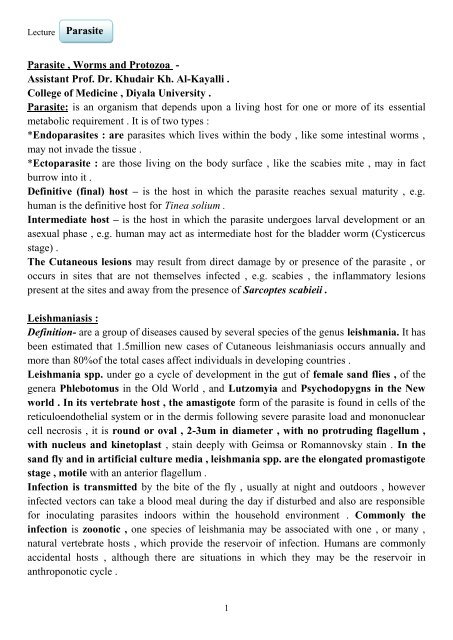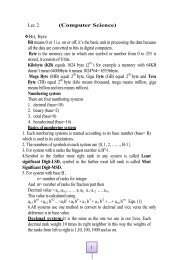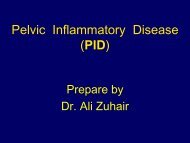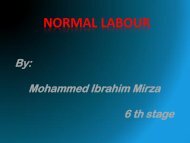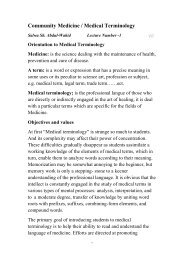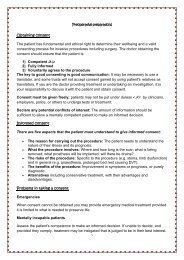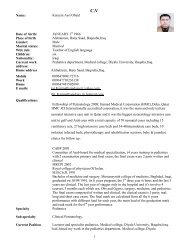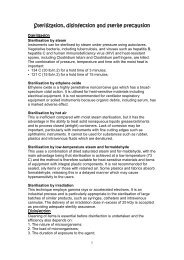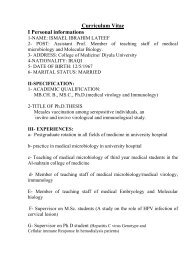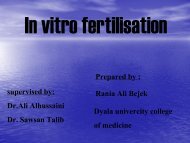Parasite , Worms and Protozoa - Assestant Prof
Parasite , Worms and Protozoa - Assestant Prof
Parasite , Worms and Protozoa - Assestant Prof
- No tags were found...
Create successful ePaper yourself
Turn your PDF publications into a flip-book with our unique Google optimized e-Paper software.
Lecture<strong>Parasite</strong><strong>Parasite</strong> , <strong>Worms</strong> <strong>and</strong> <strong>Protozoa</strong> -Assistant <strong>Prof</strong>. Dr. Khudair Kh. Al-Kayalli .College of Medicine , Diyala University .<strong>Parasite</strong>: is an organism that depends upon a living host for one or more of its essentialmetabolic requirement . It is of two types :*Endoparasites : are parasites which lives within the body , like some intestinal worms ,may not invade the tissue .*Ectoparasite : are those living on the body surface , like the scabies mite , may in factburrow into it .Definitive (final) host – is the host in which the parasite reaches sexual maturity , e.g.human is the definitive host for Tinea solium .Intermediate host – is the host in which the parasite undergoes larval development or anasexual phase , e.g. human may act as intermediate host for the bladder worm (Cysticercusstage) .The Cutaneous lesions may result from direct damage by or presence of the parasite , oroccurs in sites that are not themselves infected , e.g. scabies , the inflammatory lesionspresent at the sites <strong>and</strong> away from the presence of Sarcoptes scabieii .Leishmaniasis :Definition- are a group of diseases caused by several species of the genus leishmania. It hasbeen estimated that 1.5million new cases of Cutaneous leishmaniasis occurs annually <strong>and</strong>more than 80%of the total cases affect individuals in developing countries .Leishmania spp. under go a cycle of development in the gut of female s<strong>and</strong> flies , of thegenera Phlebotomus in the Old World , <strong>and</strong> Lutzomyia <strong>and</strong> Psychodopygns in the Newworld . In its vertebrate host , the amastigote form of the parasite is found in cells of thereticuloendothelial system or in the dermis following severe parasite load <strong>and</strong> mononuclearcell necrosis , it is round or oval , 2-3um in diameter , with no protruding flagellum ,with nucleus <strong>and</strong> kinetoplast , stain deeply with Geimsa or Romannovsky stain . In thes<strong>and</strong> fly <strong>and</strong> in artificial culture media , leishmania spp. are the elongated promastigotestage , motile with an anterior flagellum .Infection is transmitted by the bite of the fly , usually at night <strong>and</strong> outdoors , howeverinfected vectors can take a blood meal during the day if disturbed <strong>and</strong> also are responsiblefor inoculating parasites indoors within the household environment . Commonly theinfection is zoonotic , one species of leishmania may be associated with one , or many ,natural vertebrate hosts , which provide the reservoir of infection. Humans are commonlyaccidental hosts , although there are situations in which they may be the reservoir inanthroponotic cycle .1
Lecture<strong>Parasite</strong>causes viscerotropic infections in war-veterans in the middle East <strong>and</strong> in cases of Indiankala-azar .3. Cutaneous leihmaniasis due to L. aethiopica :-The lesions are most commonly central on the face <strong>and</strong> single , satellite papules acuminateinto large , spreading nodules , that may note crust or ulcerate , lesions are seldom muchinflamed <strong>and</strong> heal over 2-5years . If the s<strong>and</strong> fly bite has been on the mucosal border of thenose <strong>and</strong> mouth , primary muco-cutaneous leishmaniasis (MCL) , may develop ,producing swelling of the lips , nose <strong>and</strong> persist for many years , but without the grossdestruction seen in Latin America caused by L. brasiliensis .4. Cutaneous leishmaniasis due to L. donovani infantum :-Infants infected with this parasite tend to get visceral leishmaniasis , adults are more likelyto develop simple self-healing cutaneous disease , with out concurrent or subsequent visceralinvolvement . The appearance <strong>and</strong> evolution of the lesions is typically slow <strong>and</strong> mild , whencompared with that of L. major , with which it coexists in North Africa . Solitary mucosallesions have occasionally been reported .5. Other types of cutasneous leishmaniasis :-a. Leishmaniasis recidivans (Chronic , lupoid leishmaniasis) :- Approximately 4%of L.tropica infections from Iran <strong>and</strong> Afghanistan will develop this chronic form of the disease .Brown –red or brown-yellow papules appears , usually close to a scar of an old lesion ofcutaneous leishmaniasis or actually in the scar , they coalesce <strong>and</strong> form a plaque closelyresembling lupus vulgaris , even to the formation of apple-gelly nodules . The lesionsfrequently worsen in the summer <strong>and</strong> may ulcerate to form concentric rings , rarely keloidal<strong>and</strong> verrucous or psoriasiform forms occurs on the limps . The recidivans lesion is the resultof the failure of cellular immunity to sterilize the lesion . Investigations to demonstrate theparasite or leishmanial DNA in the infected skin are commonly negative .b. Diffuse cutaneous leishmaniasis (Disseminated Cutaneous leishmaniasis ,leishmaniasis cutis diffusa) :- In the Old-World this form of the disease id due to L.aethiopica , <strong>and</strong> has certain characteristic features , which include :-1. There is an initial lesion , which spreads locally <strong>and</strong> from which the disease disseminatesto other parts of the skin often involving large area .2. The lesions are nodules that do not ulcerate .3. There is a superabundance of parasites in the lesions .4. The histology is characteristic in that the macrophage full of amastigotes .5. Internal organs are not invaded <strong>and</strong> there is no history of kala-azar .6. The leishmanin test <strong>and</strong> other tests of specific cellular immunity are negative .7. The disease progresses slowly <strong>and</strong> become chronic .8. Treatment produce only gradual improvement <strong>and</strong> relapse is the rule .3
Lecture<strong>Parasite</strong>d. PCR to detect leishmanial DNA .Treatment- although most sores will heal spontaneously , but the role of treatment is toreduce the duration of the lesions <strong>and</strong> to minimize the scars formation . There are 2types oftherapy :-1. Local therapy- which includes :-a. Heating the sore to40-42degree C. for several hours each day by infrared light to promotehealing .b. Freezing by CO2 snow .c. Local infiltration of the lesions by 1-2ml Na. stibogluconate (pentostam) or meglumineantimoniate (one or two injections of few days apart ) , also Nacl solution 7% , or zincsulphat solution 2%(Iraqi) .2. Systemic therapy – by Na. stibogluconate or meglumine antimonite by IV or IM injectionin a single daily dose of 20mg/kg body weight for 15-21days . L. aethiopica is not sensitiveto antimony so should be treated with pentamidine isethionate in dose of 4mg salt/kg ,once weekly for as long as necessary .For patients with diffuse cutaneous leishmaniasis , treatment for many months beyondclinical <strong>and</strong> demonstrable parasitic cure was required .Leishmaniasis recidivans (lupoid) , may respond to local infiltration after nodulectomy orsystemic antimonies .Sever scaring may require plastic surgery .Diseases caused by Arthropods :-Mechanisms of skin injury by arthropods : Arthropods produces their effects on the skinby a variety of mechanisms , more than one of which may be implicated simultaneously ,which includes :1. Mechanical trauma – the puncture wound or laceration produced by the penetrationof the skin seldom causes serous disturbance to the host . There are two methods offeeding on blood : *vessels feeders ; which insert tip of their mouthparts into capillary, e.g. lice , mosquito , *pool feeders ; which lacerate the skin <strong>and</strong> damaging theblood vessels <strong>and</strong> feed on the extravasated blood e.g. flies .2. Injection of irritant , cytotoxic or pharmacologically active substances – salivarysecretions <strong>and</strong> sting venoms may contain various enzymes such as hyaluronidase ,proteases , peptidases , phospholipases , kinins , histamine liberating agents ,histamine , 5-hydroxytryptamine or acetylcholine , which produce local or if sufficientquantity , systemic effects .3. Injection of potential allergens – the vast majority of reactions to arthropods bites orstings depend upon the presence of specific antibodies to antigenic substances in the5
Lecture<strong>Parasite</strong>saliva or venom , manifested clinically as an itchy papule , weal reaction , or in somepatients as anaphylaxis .4. Secondary infections – e.g. bacteria infections like impetigo , strep. cellulites.5. Invasion of the host's tissues – certain flies causes myiasis (larvae invasion) .6. Contact reactions – ACD or ICD develops by contact with the secretions , living ordead bodies of certain arthropods .7. Reactions to retained mouthparts – as forgin body granuloma .8. Transmission of diseases – arthropods as vectors for many diseases e.g. malaria(mosquitoes) , leishmaniasis (s<strong>and</strong> fly) <strong>and</strong> typhus (lice) .Myiasis:Definition- is the infestation of the body tissues of humans <strong>and</strong> animals by the larvae ofDiptera (flies) . From entomological point of view myiasis is classified into 3types: a.Obligatory- which always pass their larval stage parasitically in the body of an animal . b.Facultative which usually developed on decaying flesh or vegetable matter , but may infestwounds . c. Accidental- in which the eggs or larvae of Diptera are ingested in food or drink, producing intestinal myiasis . While clinically myiasis is classified according to the part ofthe body affected , there are :- a. Cutaneous myiasis (wound myiasis <strong>and</strong> furuncularmyiasis) . b. Nasopharyngeal myiasis . c. Ophthalmomyiasis . d. Intestinal myiasis . e.Urogenital myiasis .Clinical features- the habits of the flies <strong>and</strong> their larvae determined the variations in theclinical manifestations . Traumatic or wound myiasis has been a serious complication ofWar wounds in tropical areas , <strong>and</strong> is some times seen in neglected ulcers or wounds in mostpart of the World .Obligatory Cutaneous myiasis – occurs in two main clinical forms , in both , there may bemild constitutional symptoms <strong>and</strong> eosinophilia . Both occurs mainly on exposed skin , oftenthe face , scalp , arms <strong>and</strong> legs . 1. Furuncular form , boil-like lesions developedgradually over a few days , each lesion has a central punctum , which dischargesserosanguineous fluid . The posterior end of the larvae , equipped with a group of spiracles ,is usually visible in the punctum <strong>and</strong> its movement may be noticed by the patient . Thelesions are often extremely painful , <strong>and</strong> may be accompanied by lymphangitis <strong>and</strong> regionallymphadenopathy . Once the larvae has emerged , or has been removed , the lesions rapidlyresolve , the flies causing furuncular myiasis in humans are Dermatobia hominis , Cuterebra ,Cordylobia , <strong>and</strong> Hypo derma species .2. Creeping eruption – in which a tortuous , thread –like red line with a terminal vesiclemarks the passage of the larvae through the skin . The larvae lies ahead of the vesicle inapparently normal skin , this form is produced by Gasterophilus larvae .6
Lecture<strong>Parasite</strong>Treatment – by removal of larvae by expression , surgically or application of mineral oil ,petrolatum or butter (Vaseline) .Lice (Phthiraptera) :Lice are members of the order Phthiraptera <strong>and</strong> suborder Anoplura , they are wingless ,dorso-ventrally flattened insects , which are obligate blood-sucking ectoparasites of birds <strong>and</strong>mammals . The Phthiraptera are highly host-specific <strong>and</strong> spend their entire lives on the host.The Anoplura are vessels feeders (solenophages) , introducing their mouthparts directly in toa blood vessels to withdraw blood .Humans are parasitized by three species of Anoplura : Pediculus capitis (head louse) ,Pediculus humanus (clothing or body louse) , <strong>and</strong> Pthirus pubis (pubic or crablouse) .Head lice <strong>and</strong> clothing lice are morphologically almost identical , <strong>and</strong> are capable ofinterbreeding , pthirus pubis is morphologically quite distinct from .Pediculus (Pediculosis) capitis :The adult female is a grayish –white insect 3-4mm long , the male is slightly smaller , theclaws on the legs are adapted for clinging to hair . During her lifespan of approximately40days , the female is capable of laying about 300eggs at the rate of 7-10daily , the eggs arecemented to hair shafts with a chitinous cement material secreted by the female's accessorygl<strong>and</strong>s , close to the surface of the scalp , they are oval , flash cloured , hatch in about 8days ,<strong>and</strong> the louse nymph reaches maturity in approximately 10days , the empty egg (nit) appearswhite <strong>and</strong> easily seen .Prevalence- it has a worldwide distribution , common both in developed <strong>and</strong> developingcountries , more common in rural areas , <strong>and</strong> in children between 3-11years age , frequentlygirls , with long hair . The majority of head louse infections are acquired by direct head tohead contact , spread of lice is encouraged by poverty , poor hygiene <strong>and</strong> overcrowding .Clinical features- scalp pruritis is the characteristic feature of head louse infection (may beasymptomatic) , secondary bacterial infection (impetigo) may occur as a result of scratching .Pruritic papular lesions may occur on the nape of the neck , <strong>and</strong> occasionally a generalizednon-specific pruritic eruption develops . The empty egg cases ( nits) are easily identified ,<strong>and</strong> occur in greatest density on the parietal <strong>and</strong> occipital regions , they may be confusedwith peripilar keratin casts . Detection of adult lice <strong>and</strong> nymphs provides evidence of anactive infection , whereas the presence of eggs <strong>and</strong> egg cases alone merely indicates thatinfection has occurred at some time.Treatment :a. Chemical treatment – which include :1. Malathion <strong>and</strong> carbaryl (carbaril) – are acetyl cholinesterase inhibiting insecticides ,both are efficient pediculicides <strong>and</strong> have good , but not complete , ovicidal activity , it isrecommended that lotion (alcoholic basis) , <strong>and</strong> liquid (aqueous basis) formulation of both7
Lecture<strong>Parasite</strong>should remain on the scalp for 12ho. , before being washed off . Hot-air-hair dryer shouldnot be used after their application , because both are degraded by heat , treatment should berepeated after 10dayes , to deal with any nymphs which emerge from the eggs .2. Pyrethrins synergized with piperonyl butoxide <strong>and</strong> the synthetic pyrethroidspermethrin <strong>and</strong> phenothrin – lotion <strong>and</strong> liquid formulation are preferable to shampoos(latter one exposed the insects to relatively low concentrations , which lead to developmentof resistance) . Aqueous basis are less likely to irritate an excoriated scalp , than alcoholicsolutions , also do not irritate asthmatics , <strong>and</strong> are not flammable.3. USA head louse treatment – a combination therapy containing 1% lindane ,1%permethrin , 0.5%malathion <strong>and</strong> pyrethrin synergized with piperonyl butoxide , carriedout on lice <strong>and</strong> eggs .b. Physical treatment : is an alternative to the use of chemical agents :-1. Bug Busting (wet-combing method) – this technique involves ordinary shampooing ofthe hair , followed by application of generous amounts of conditioner , <strong>and</strong> combing using afine –tooth comb to remove lice , is repeated every 4days for 2weeks . malathion lotion wastwice as effective as this method .2. A battery –powered device (Robi-comb) , which kills lice as it used to comb through thehair . Notes- family members should be examined , development of resistance changed to another insecticides .c. Other therapies :- 1. Topical crotamiton (escabule) lotion .2. Topical <strong>and</strong> oral ivermectin (orally 200ug/kg body weight) , as single dose , repeatedafter 10days , but not ovicidal .3. Oral co-trimaxazol – which is ingested by the louse <strong>and</strong> affects its symbiotic bacteria ,which are essential for vitamins B synthesis , so the louse cannot survive .Pediculus (pediculosis) humanus (clothing , body lice , pediculosis corporis) :It is almost identical in appearance <strong>and</strong> development to the head louse , it's natural habitant isthe clothing of it's host , <strong>and</strong> it only visits the skin to feed , its eggs are cemented to clothingfibers , with a preference for clothing close to the skin . It is the parasite of individuals whoseclothing is rarely changed or washed , because the louse <strong>and</strong> it's eggs will not survive hightemperature washing <strong>and</strong> ironing , <strong>and</strong> it is intolerant of temperature changes in it'senvironment .Prevalence- it occurs through out the world , although it is now uncommon in developedcountries , it is the louse of poverty <strong>and</strong> neglect , flourished in over crowded , who rarelyremove their clothing . In most infected individuals the population is small , but in somethere may be thous<strong>and</strong>s of lice . This louse is the vector of epidemic typhus , trench fever<strong>and</strong> louse –borne relapsing fever .8
Lecture<strong>Parasite</strong>Clinical features- itching is the principle complaint , which is the result of sensitization tolouse salivary antigens , other acquired tolerance to the bites are asymptomatic . Itchingcauses excoriations <strong>and</strong> there may be secondary bacterial infections , later on the skin oftenbecome hyperpigmented (so called 'Vagabonds' disease , morbus errorum) . Lice <strong>and</strong>eggs should be sought in the clothing .Treatment – the clothing , not the patient requires treatment . *Tumble-drying is the mosteffective means of killing both lice <strong>and</strong> eggs , high temperature laundering ofundergarments <strong>and</strong> dry cleaning of outer clothing are also effective .*Malathion dusting powder , <strong>and</strong> more recently permethrin treated clothing has beenshown to be toxic to clothing lice .*Previously DDT (dichlorodiphenyltrichloroethane) <strong>and</strong> lindane are used , but liceresistance was developed .Phthirus pubis (Crab lice , phthiriasis pubis) :It is quite distinctive , it's body is squat <strong>and</strong> the second <strong>and</strong> third pairs of legs carry heavy ,pincer-like claws , to grip adjacent hairs close to the skin surface . The eggs are light brownin colour <strong>and</strong> cemented to the hair of the host , it colonize axillary hair , eyebrows , eyelashes, beard hair , scalp margins <strong>and</strong> hair on the trunk <strong>and</strong> limbs , in addition to pubic hair . Thecrab louse become active at night , when the host is sleeping , has difficulty in moving whentaken from its host , where as the head <strong>and</strong> body lice are quite mobile out off the host .Phthirus pubis is a specific parasite of humans , but it's transfer to a dog has been recorded .Prevalence- crab lice are transmitted by close physical contact , usually sexual , it appears tobe a common disorder among sexually active young adults , who are found to be sufferingfrom other sexually transmitted infections (STDS) .Clinical features- itching mainly in the evening <strong>and</strong> at night , is the principal symptom ,close inspection of affected areas will reveal lice grasping hair close to the skin surface , <strong>and</strong>louse eggs attached to the hair shafts , louse feces are often visible as rust-coloured speckleson the skin <strong>and</strong> hair , <strong>and</strong> the under clothes may be spotted with altered blood . Blue-greymacules (maculae caeruleae) are occasionally seen on the skin . In children crab lice maycolonize the eyelashes <strong>and</strong> scalp , which is usually acquired by close physical contact withinfected parents <strong>and</strong> occasionally as a result of sexual abuse .Treatment- malathion , pyrethrins with piperonyl butoxide , pyrethroids <strong>and</strong> carbaryl ,may be used to eradicate crab lice , it is preferable to treat the whole of the trunk <strong>and</strong> limbs ,<strong>and</strong> the scalp may also require treatment , an aqueous base is preferable . Treatment shouldbe repeated after an interval of 7-10days , all sexual contacts should also be treated .Eyelashes infection (phthiriasis palpebrarum) is treated by either mechanical removal oflice <strong>and</strong> eggs with fine forceps or epilation of the lashes with their attached eggs <strong>and</strong> lice ,9
Lecture<strong>Parasite</strong>but petrolatum ointment used as a thick application twice/day for 2-3weeks is the treatmentof choice , other methods are criotherapy , argon laser .Bugs (Hemiptera) including bedbugs :Bedbugs are blood sucking , temporary ectoparasites of birds <strong>and</strong> mammals , it is 4-5mm inlength , with dorsoventrally flattened , oval bodies , the four wings reduced to scale-like pads, <strong>and</strong> the hind wings are absent , each female lays about 300eggs in her life-time , in thecrevices of floors <strong>and</strong> walls , furniture , bed frames <strong>and</strong> mattresses , which hatched afterabout 10days to nymphal stage , which last approximately 6weeks . Bedbugs normally feedat night , usually about an hour before dawn , but they may feed during the day , in theabsence of a suitable food supply , however , adult bedbugs can survive starvation , in idealcircumstances for a year or more .Clinical features- the bites of the bedbugs are painless , but it produces a reaction on thesites , commonly affected areas are the face , neck , h<strong>and</strong>s <strong>and</strong> arms , but occasionally begeneralized . In the first exposure , only a purpuric macule indicates the site of the bite , butin previously exposed , sensitized subjects , intensely irritating weals or papules surmountedby haemorrhagic puncta , <strong>and</strong> in some cases in which the reaction is sever , bullaepredominate . Bedbugs act as a possible vectors for transmission of hepatitis B <strong>and</strong> HIV.Bedbugs are one of the causes of papular urticaria .Papular urticaria :It is an immediate IgE –mediated reaction , results from injection of forgin protein by bitingof insects into skin of the most sensitive subjects , these insects includes : bedbugs , fleas ,mosquito , s<strong>and</strong> fly <strong>and</strong> some time sarcoptus scabiaii mite .Clinical features- there is a punctum visible on the weal which may blister . Some times thereaction evolves into delayed hypersensitivity reaction leading to intensely itchy , induratedpapules lasting weeks or months , with signs of excoriation <strong>and</strong> some times secondarybacterial infection . It is most commonly seen on the legs of children , also on the forearms ,sometimes on the face , during early summer <strong>and</strong> autium times , usually recurrent for severalyears .Treatment- eradication of insects by insecticide (DDT, malathion) , topical steroid mixedwith antibiotic if infection are present , oral antihistamine to control the itching .Scabies :Definition- it is parasitic contagious disease of humans <strong>and</strong> other animals , caused by mitesof the family Sarcoptidae , which includes Sarcoptes scabiei (scabies mite human) , <strong>and</strong>Notoedres cati (a mange mite of cats , which cause scabies in other animals) .Human scabies : it is of two types ordinary <strong>and</strong> Norwegian scabies .11
Lecture<strong>Parasite</strong>3. Monosulfiram – a 25% solution in industrial methylated spirit is diluted with2or3parts of water to form emulsion immediately prior to application , as thesuspension is unstable , applied once daily for 2-3days , may cause flashing , sweating<strong>and</strong> tachycardia , monosulfiram soap has been used as a prophylactic , where scabiesis endemic .4. Malathion -0.5% in aqueous base , for 24hours , repeated after a week .5. Permethrin- 5% dermal cream is an effective , scabicidal , washed of after 8-12hours, repeated after an interval of a week .6. Gamma benzene hexachloride (lindane)- a single application of 1%washed off after12-24hours is usually recommended , it is absorbed through the skin , especially if thebarrier function of the epidermis is compromised , which may be result in adverseneurological effects , principally seizures .7. Other topical treatments- includes thiabendazole <strong>and</strong> crotamiton , both have limitedscabicidal activity , <strong>and</strong> several applications on consecutive days are required .8. Ivermectin – is structurally similar to the macrolide antibiotics , but dose not haveantibacterial activity , it is active against a number of ecto-<strong>and</strong>oparasites . Can be usedtopically or orally <strong>and</strong> is safe in both children <strong>and</strong> adult , a single dose of 200ug/kg ofbody weight will be effective in many cases of ordinary scabies , but presumablybecause of a lack of ovicidal activity , higher cure rates are obtained with two dosesseparated by an interval of a week , it is indicated in institutional outbreaks of scabiese.g. in prisoners .It was suggested that permethrin 5% , is the preferred treatment for scabies in thepresent time .Liquid scabicides are most conveniently applied with 2-inch (5cm) pain brush , to the wholebody except the head <strong>and</strong> neck , although the latter should be included if there is clinicalevidence of involvement <strong>and</strong> a non-irritant agent employed . Advice that itching will persistfor a few days up to 2weeks , All members of the family <strong>and</strong> close physical contacts shouldbe treated , whether symptomatic or not , <strong>and</strong> ordinary laundering of clothing <strong>and</strong> bedding ,with treatment of secondary infection <strong>and</strong> eczematization .Treatment of infants <strong>and</strong> young children –benzyl benzoate should be diluted with 2or3parts of water , permethrin cream is the treatment of choice .All scabicides must have beenused on pregnant women , in breast feeding women , it would appear preferable to stopbreast feeding during <strong>and</strong> for few days after treatment , to allow plasma levels of anypercutaneously absorbed scabicide to fall .Crusted scabies (Norwegian scabies) :It is firstly described in Norway , so called Norwegian scabies , in which huge number ofmites were presented , it's name was replaced by crusted scabies .13
Lecture<strong>Parasite</strong>Aetiology <strong>and</strong> pathogenesis – in common or ordinary scabies there are few mites , probablybecause scratching destroys the burrows <strong>and</strong> a good st<strong>and</strong>ard of hygiene may also help tocontrol the mite population . In crusted scabies , the host's response to the mites is modified, allowing them to multiply , skin anesthesia secondary to sensory neuropathy or spinalinjury , mental retardation , dementia <strong>and</strong> down's syndrome is frequent association ,immunosuppression is also important factor (either due to disease or therapy) .Clinical features- large , warty , crusts form on the h<strong>and</strong>s <strong>and</strong> feet , the palms <strong>and</strong> soles maybe irregularly thickened <strong>and</strong> fissured , masses of horny debris accumulate beneath thickened<strong>and</strong> discoloured nail . Erythema <strong>and</strong> scaling occurs on the face , neck , scalp <strong>and</strong> trunk <strong>and</strong>may be generalized , the extent of the erythroderma <strong>and</strong> the warty plaques varies greatly <strong>and</strong>either may predominant , itching is often absent or slight , but may occasionally be sever .Generalized lymphadenopathy <strong>and</strong> blood eosinophilia are common .Diagnosis – DD. from hyperkeratotic eczema , psoriasis , Dariers's disease <strong>and</strong> contactdermatitis , the clinical diagnosis is readily confirmed by examination of scraping for mites<strong>and</strong> eggs .Treatment- admission to hospital , treated by topical scabicides , but several applications forprolonged period is often required <strong>and</strong> incomplete response is not uncommon . Recentlyivermectin has become the treatment of choice , either alone or in combination with topicalagent , two doses of (200ug/kg) , separated by an interval of week <strong>and</strong> cut the nails shortly .14


